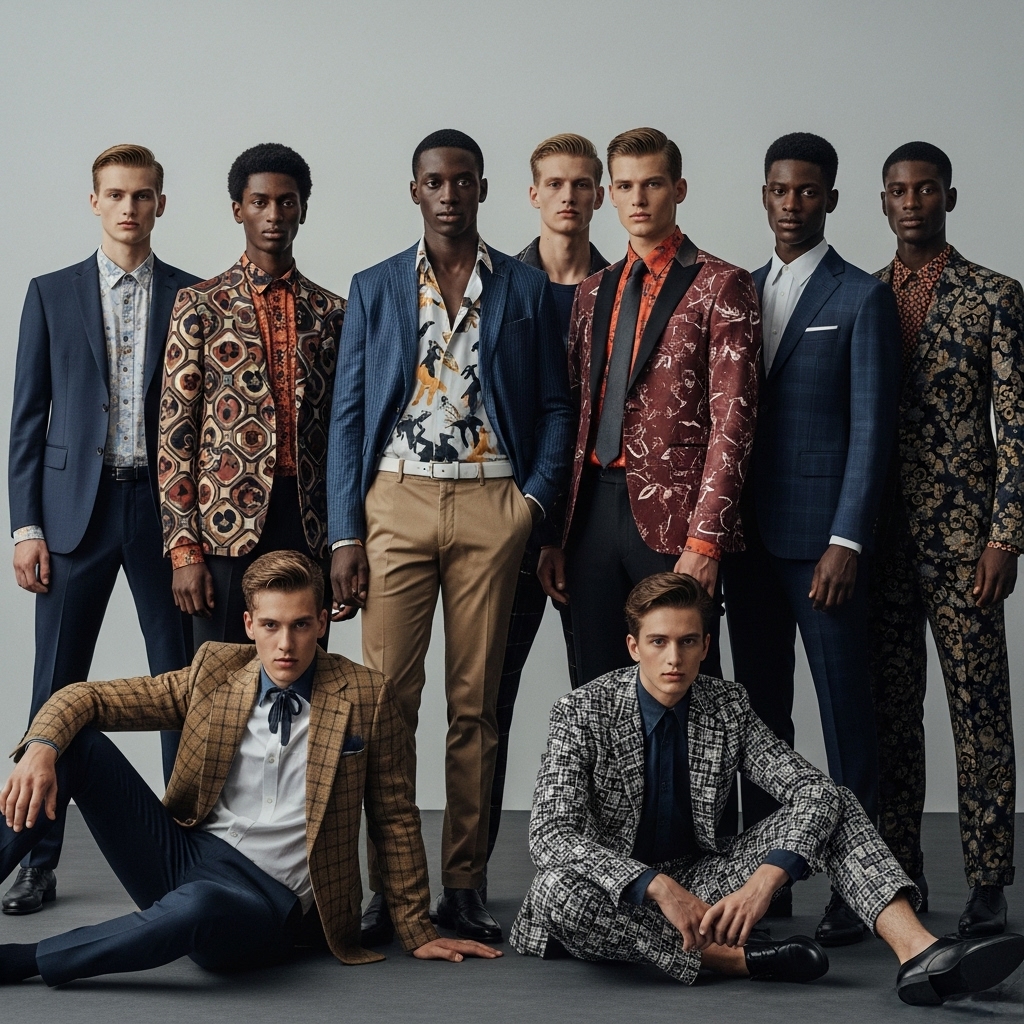Blog
Fashion and the Male Gaze: Evolving Masculinity in Menswear

For centuries, menswear has served as a fascinating barometer of evolving masculinity. From the elaborate finery of kings to the sober uniformity of the modern suit, male attire has consistently reflected societal expectations, shifting ideals of power, and changing definitions of what it means to be a man. However, in the 21st century, this relationship is undergoing its most radical transformation yet, as contemporary fashion actively challenges traditional gender norms and embraces a fluidity that reimagines masculinity itself.
Historically, menswear has oscillated between periods of flamboyant expression and austere conservatism. In the 17th and 18th centuries, European aristocrats, particularly at courts like Versailles, embraced extravagant fashions: silk brocades, lace cuffs, powdered wigs, and high heels were symbols of status and power. The dandy movement in the early 19th century, led by figures like Beau Brummell, ushered in an era of understated elegance, emphasizing impeccable tailoring, fit, and quality fabrics over excessive ornamentation. This period laid the groundwork for the modern suit, which would come to dominate menswear for the next two centuries.
The 19th and much of the 20th centuries saw the suit emerge as the quintessential uniform of masculinity. It became synonymous with professionalism, respectability, and financial success. The clean lines, muted colors, and structured silhouettes of the business suit reflected a societal emphasis on rationality, restraint, and the seriousness of the male role in public life. This period often saw a suppression of overt self-expression in men’s clothing, with deviations from the norm often viewed as unconventional or rebellious. Fashion for men became largely about subtle distinctions in cut, fabric, and accessories rather than dramatic changes in silhouette.
However, the mid-20th century began to chip away at this rigid conformity. The “Peacock Revolution” of the 1960s and 70s saw a resurgence of vibrant colors, patterns, and more experimental silhouettes in menswear. Influenced by rock and roll, youth culture, and a burgeoning counter-culture movement, men began to embrace individuality and expressiveness in their clothing, challenging the staid conventions of their fathers’ generations. Flare pants, wide lapels, and bold prints became commonplace, marking a significant departure from previous decades.
The late 20th and early 21st centuries witnessed a profound casualization of menswear. The rise of sportswear, driven by advancements in athletic wear technology and the increasing influence of street culture, saw hoodies, sneakers, and tracksuits move from the gym to mainstream everyday wear. This shift reflected a growing societal emphasis on comfort, active lifestyles, and a blurring of the lines between formal and informal occasions. Streetwear, in particular, became a global phenomenon, originating from subcultures and becoming a dominant force, influencing high fashion brands and dictating trends from the ground up. This movement allowed men to experiment with bold graphics, oversized silhouettes, and eclectic layering, fostering a new kind of creative expression.
Perhaps the most significant evolution in contemporary menswear is the increasing blurring of gender boundaries. Designers are actively creating gender-fluid and gender-neutral collections, challenging traditional notions of “masculine” dress. Skirts for men, previously reserved for specific cultural garments (like the kilt) or counter-cultural movements, are appearing on runways and in mainstream retail. Androgynous aesthetics, once niche, are gaining wider acceptance, with fashion icons and celebrities embracing styles that defy conventional gender categorization. This reflects a broader societal conversation about identity, fluidity, and a rejection of restrictive gender roles, allowing men greater freedom to express themselves without being confined to narrow definitions of masculinity.
The influence of celebrities, athletes, and street style icons is paramount in this evolution. Figures like Harry Styles, Timothée Chalamet, and the late Virgil Abloh have pushed boundaries, making bold fashion choices that often incorporate elements traditionally considered feminine, or simply pushing for more adventurous and expressive styles for men. Their choices trickle down, inspiring millions to experiment and embrace a more diverse palette of sartorial options.
The business of menswear has also seen exponential growth and diversification. Beyond clothing, there’s been a significant expansion in the male grooming market, men’s accessories, and luxury items specifically tailored for men. This indicates a greater willingness among men to invest in their appearance and embrace fashion as a legitimate avenue for self-care and personal expression.
Looking to the future of masculinity in fashion, we can expect a continued movement towards personalized expression and a further breakdown of traditional gender codes. The lines between men’s and women’s fashion will likely continue to blur, leading to more inclusive designs and marketing. Comfort, versatility, and sustainability will remain key drivers, but the overarching theme will be the freedom for men to define and express their masculinity in myriad, authentic ways, unconstrained by historical expectations.
In conclusion, menswear is no longer confined to the rigid definitions of the past. It is an exciting and rapidly evolving landscape, reflecting a society that is increasingly open to diverse expressions of identity. From the tailored suit to the gender-fluid ensemble, men’s fashion continues to be a powerful mirror, reflecting a dynamic and ever-expanding definition of what it means to be masculine in the modern world.
